In our How to Paint Everything series, we take a look at different armies of the Warhammer universe, examine their history and heraldry, and look at several different methods for painting them. This week we’re going down to 6mm scale, looking at the teeny tiny planes of Aeronautica Imperialis. First up, it’s the Orks!
With the imminent release of Skies of Fire we thought it was high time to talk about painting tiny planes, and where better to start than with the Boyz? Orks were one of the two original factions in the re-released Aeronautica Imperialis, with the Air Waaaagh! facing off against the Imperial Navy in the Rynn’s World starter set. Painting Aeronautica Imperialis models at 6mm scale is a very different challenge to 28mm – in big 40k a single plane is a centrepiece project all by itself, whereas in AI they’re more or less your whole army, except for some ground assets. The models are smaller and the details finer, but this gives you an opportunity to try out some different techniques that can look great at the smaller scale. Orks of course bring their own unique aesthetic to the world of tiny planes, presenting excellent opportunities for trying out some weathering and freehand. Two of our authors, Thundercloud and Raf Cordero, got together to write up how they approached painting their own Air Waaaaghs. Check it out below!
Thundercloud
There are a number of approaches that you can take with the Ork planes in Aeronautica, and it is entirely up to you which one you take. I painted my models fairly quickly to get a lot of points on the table as soon as possible, but since you can play games as small as 50 points practically then if you want to take the time to have individual schemes and go high quality rather than tabletop standard, you are still only painting a dozen models for what is essentially a skirmish game.
As with all painting projects, a little planning at the beginning as to what to get and what to paint makes a big difference. I went with the starter set and one of each box, giving me 9 Dakkajets, 6 Fighta Bombers, 2 Eavy Bommers and 2 Grot Bommers plus a set of Ork ground assets.
I painted up enough to be able to field 400 points easily, but everything together easily exceeds 500 points. I’d never deploy that in one battle, but it lets me play any scenario in the game and theme my force how I like (I could conceivably field over 150 points of Dakkajets or Fighta Bommers).

I did five of my Fighta Bombers as superiority builds (kustom shootas and rokkits to smack Thunderbolts) and if I was doing it again I’d have done 2 or 3 as bomber builds to allow me to play ground attack missions with dakkajets and fighta bombers rather than bring an Eavy Bommer.
So when you are planning your force, and your colour scheme, think about the sort of squadrons you want to fly. Will you have a lot of aces with individual schemes? Or a dakkajet horde from a particular clan? Will every plane be individual, or a scheme you can quickly replicate to get a force on the table?

What colour scheme do you use?
There are strong and vibrant colour schemes to be had from the Ork clan schemes that any Ork player is already familiar with (the yellow of the Bad Moonz, the red of the Evil Sunz, the blue of the Death Skullz, etc).

Or you can create your own, basing it on either a historical scheme (I’ve seen a couple of people base them on the bare metal of the early Jet Age) or WWI schemes based around bright colours as seen on the Western Front.
I’ve gone with a mix of clan colours for my Air Waagh, though I started out painting my starter set planes red to get them very quickly done ready to run demos.
Quick and Dirty Red Scheme
https://www.youtube.com/watch?v=22elLsWjHxk
This video breaks down my painting method for my starter set planes. A colour spray undercoat forms the basis of the paint job, followed by a wash to bring out the panel lines, then drybrushing to provide highlights. Details are then picked out including all the metallics. There is the option to pick out some panels in different colours to provide contrast, and using a colour wheel to pick contrasting or complimentary colours is a good idea. On red planes some details in light blue provide a stark contrast, while orange or brown panels would compliment the warm main colour.
With metallics you’ll want a steel and a brass or gold, and you’ll want to pick a wash for them. I used nuln and then agrax, but you can warm or cool your metallics using blue or orange/rust washes, and use this as another complimentary colour in your palette, to compliment or contrast your main colour.
This turns into an exercise in when to say stop. There is a reasonable amount of detail on the models, including the lower surfaces which will be quite rarely looked at. Do you need to paint bare wires and control panels there? Of course you do, but no one’s going to stand over and make you do it. You just have to live with yourself if you don’t.
Similarly rivets. There are a lot of rivets on the Ork planes. Gotta paint them all!
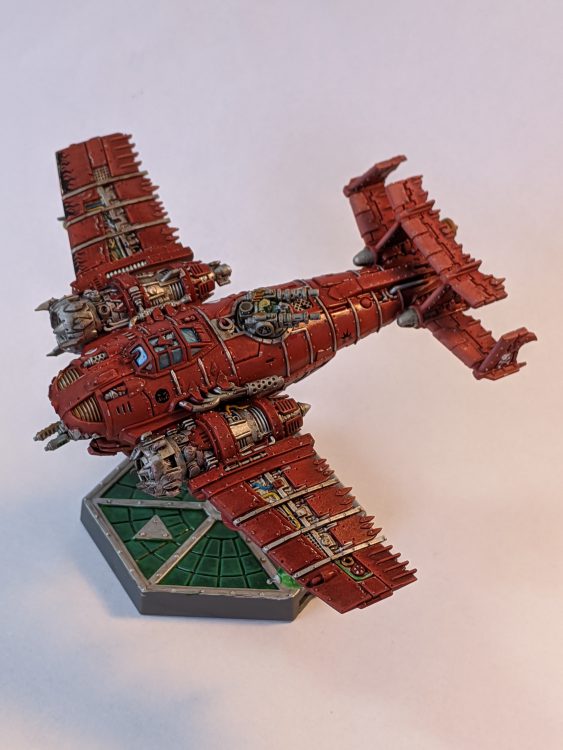
Going crazy
With Orks you can justify a very bright, comic book like colour scheme using primary colours, but there is also space for something a little more out there. Again you can look to historical aircraft schemes, and instead of copying camo schemes like Imperials often do, focus on the more striking schemes from history. You can also go far more cartoony and produce an almost harlequin style aircraft with painting panels different colours.
The recent AI batrep on Warhammer TV featured a dazzle pattern Ork squadron, and it is the imaginative and more extreme schemes that some will find eye catching.
Modern aircraft have some eye-catching schemes as well, and are easy to find colour photos of.

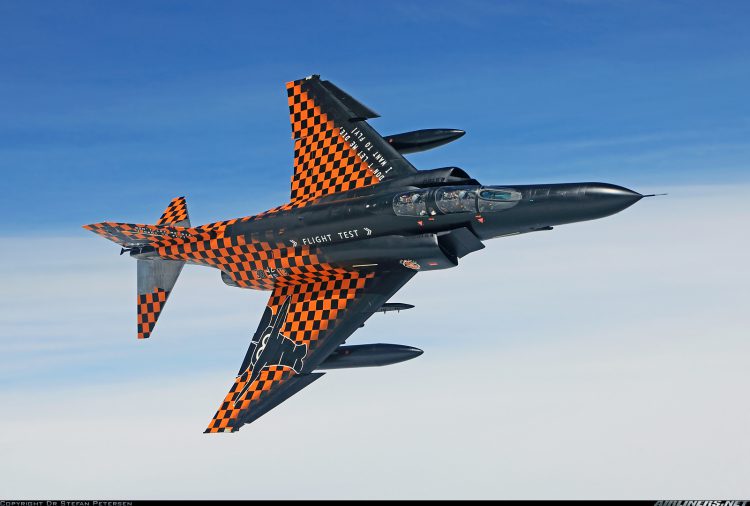
Transfers
The black and white transfer sets provided in the kits is invaluable for adding details if you can’t freehand flames, checks or dags, as well as providing a number of insignia. The white insignia can be coloured with glazes, as many people assume was done with the display models on the starter box (in fact these are all freehand, yes, even the Imperial Ace wing markings as you can tell by looking very closely). You can trim these transfers, particularly the dags, flames and checks, as you will want to apply them to specific panels and wing edges, and the Orks don’t have uniformly even edges due to the additional patch plates on the wing edges and the structural beams on the wings of the larger Ork aircraft.
With models this size transfers make a big difference, and some sort of decal softener (micro sol and micro set being the obvious choice) helps to remove the shiny edge of the transfer and for the transfer to meet the contours of the model.
Raf
Unlike my Imperial side (article coming soon!) my Ork paint schemes are fairly standard.
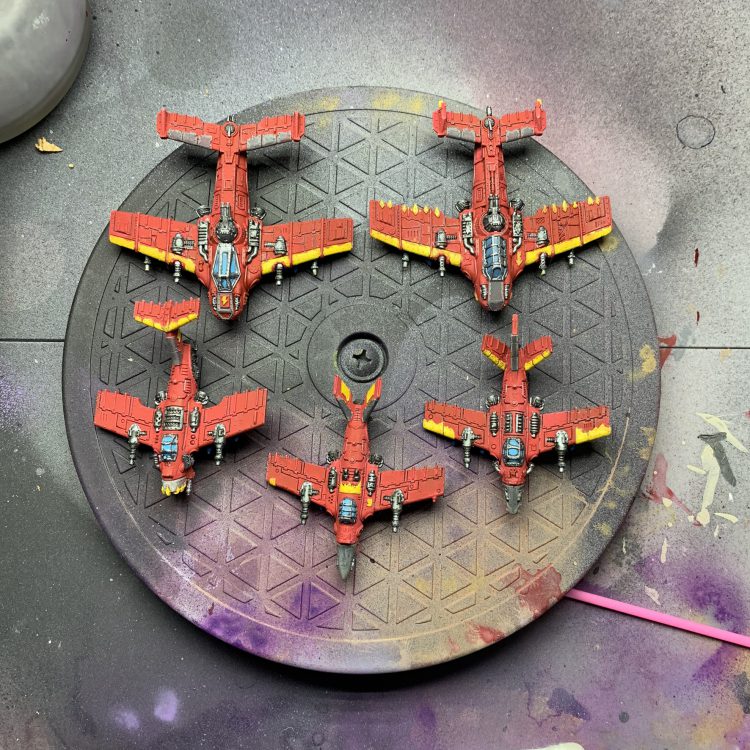
To paint these, I started with a white primer and then hit them all over with Citadel Mephiston Red Air paint through the airbrush. From there the big decision was how many of the little details did I want to paint. There really are tons of molded details in Aeronautica planes. It’s impressive, but it means you can paint for days. I decided to just make sure there was some yellow to provide a contrast, and that I picked out enough metal to show the engines. Some Tamiya Panel Liner finished it off.
For the planes in my Bomma squadron, I took the time to do a little more detail.
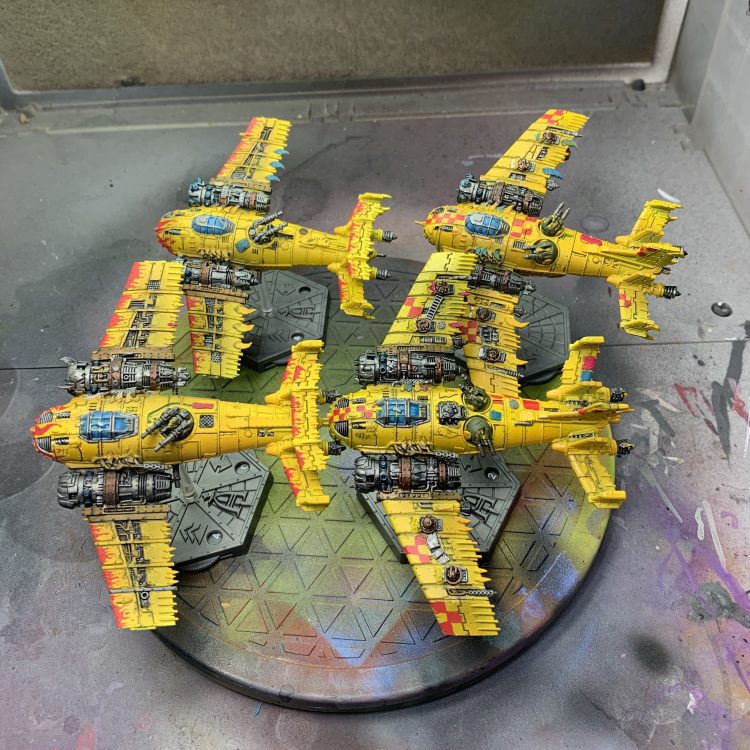
These were also intended to be speed paints, but then I decided it would be a good time to try flames and checks for the first time. As is pretty normal for me lately, I decided to just start throwing new techniques and painting processes at these.
The yellow was done by spraying Yellow Dahler Rowney Ink over white. That created a sort of neon greenish yellow, so I then sprayed Casandora Yellow wash to bring the yellow down to normal. It looks fine and was easy, but probably would have been easier to just use a yellow paint.
The metallics are Scale75 Black Metal with a Heavy Metal drybrush. All the colored metal (brass, brown, and blue plasma conduits on the engines) were done by layering GW Contrast paints right over the metal. I love this technique but I should have put it over brighter metal.
For the freehand, I just decided to grab a size 0 brush and give it a shot. I used the tutorial that Benedict Crumblebatch wrote for us here on Goonhammer, and it went faster than expected. I finished off by painting a bunch of the extra panels riveted to the body in various colors. The idea is that the orks have had to weld patch repairs using looted scrap so the colors are a little hodgepodge. The ‘Eavy Bommas got flames and the Grot Bommas got checks.
They aren’t going to win any contests, but I got threw these in only a few nights and now they’re ready to rock.
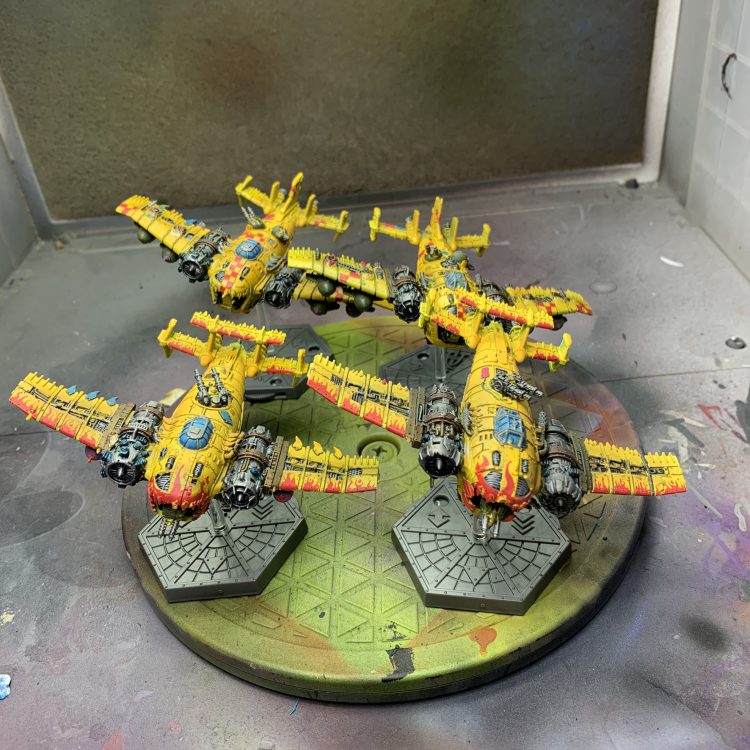
Wrap-up
With Orks, sit down and sketch out what you want to do, whether to use clans or another scheme, and what techniques you want to use. Plan your colour palette, and look at some pictures of planes and various schemes.
If you are painting quickly coloured spray undercoats or an airbrush basecoat are a good foundation. A few core colours throughout the fleet keep a strong colour scheme. Decide on whether to do cool metals with a blue or black wash or warm metals with an agrax or rust wash.
Pick a level of detail you are happy with, and paint to that level. Are you painting 15 planes and ground objectives for an upcoming tournament? Maybe not a super high level of detail. Painting a 100 point force for display? Every rivet is getting done.
As with all projects, think, plan and execute. And if you fancy chatting about it, the Aeronautica Imperialis 2019 Facebook group is a great place to hash out ideas.
If you have any comments or feedback, then of course as ever feel free to comment below, hit us up on Facebook, or e-mail as at contact@goonhammer.com.


